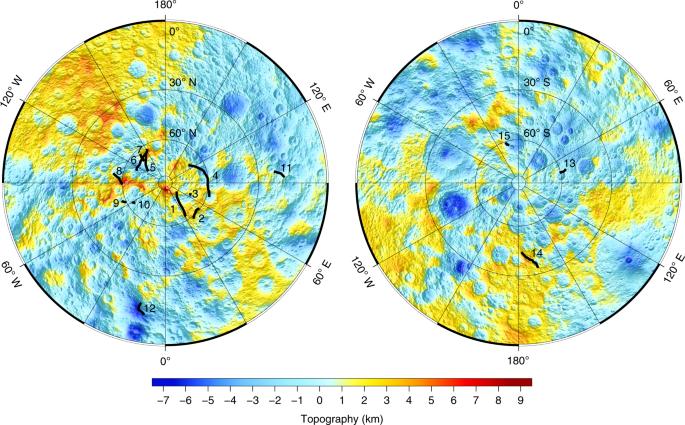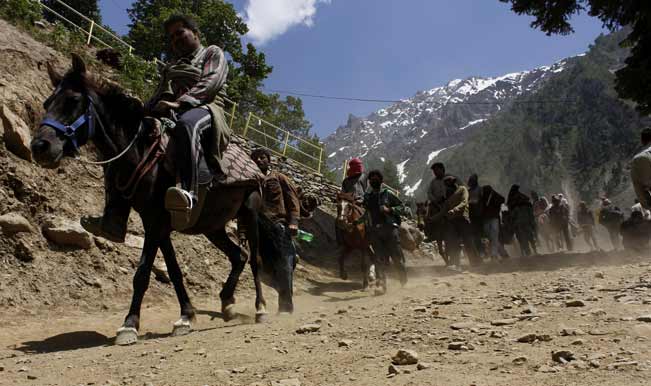
- Select a language for the TTS:
- UK English Female
- UK English Male
- US English Female
- US English Male
- Australian Female
- Australian Male
- Language selected: (auto detect) - EN
Play all audios:
ABSTRACT The surface of the dwarf planet Ceres is considered to be dominated by geological processes typical of small bodies or medium-sized icy bodies, such as impact cratering1,2; there
are also features of putative cryovolcanic origin3 as well as those related to flow of near-surface ice4. Extensional features4,5,6 include regional linear troughs, fractures and pit chains,
fractures associated with impact craters and with crater floors, and polygonal craters whose walls seem to be structurally controlled. However, no contractional features, which are related
to thrust fault activity more typical of large silicate bodies7,8,9,10,11, have been described. Here we report the presence of scarps, ridges and fractures associated with thrust faults,
tectonically raised terrains and thrusted craters—all contractional features. These structures closely resemble thrust-fault-related lobate scarps on Mercury7,8 and Mars9,10, albeit with
lower displacement. They seem more abundant in high-latitude ancient terrains, perhaps owing to illumination effects that aid identification. The observed deformation implies that the
crustal material is stronger than water ice but weaker than silicate rocks, consistent with our current knowledge of crustal composition12 and rheology13. These features suggest that
large-scale contraction, possibly related to differentiation processes, occurred in the history of Ceres. Access through your institution Buy or subscribe This is a preview of subscription
content, access via your institution ACCESS OPTIONS Access through your institution Access Nature and 54 other Nature Portfolio journals Get Nature+, our best-value online-access
subscription $29.99 / 30 days cancel any time Learn more Subscribe to this journal Receive 12 digital issues and online access to articles $119.00 per year only $9.92 per issue Learn more
Buy this article * Purchase on SpringerLink * Instant access to full article PDF Buy now Prices may be subject to local taxes which are calculated during checkout ADDITIONAL ACCESS OPTIONS:
* Log in * Learn about institutional subscriptions * Read our FAQs * Contact customer support SIMILAR CONTENT BEING VIEWED BY OTHERS POST-IMPACT CRYO-HYDROLOGIC FORMATION OF SMALL MOUNDS AND
HILLS IN CERES’S OCCATOR CRATER Article 10 August 2020 COEVAL UPPER CRUSTAL EXTENSION AND SURFACE UPLIFT IN THE CENTRAL TAURIDES (TÜRKIYE) ABOVE THE CYPRUS SUBDUCTION ZONE Article Open
access 25 April 2025 HOT CORDILLERAN HINTERLAND PROMOTED LOWER CRUST MOBILITY AND DECOUPLING OF LARAMIDE DEFORMATION Article Open access 04 May 2024 DATA AVAILABILITY The data that support
the plots within this paper and other findings of this study are available from the corresponding author on reasonable request. REFERENCES * Russell, C. T. et al. Dawn arrives at Ceres:
exploration of a small volatile-rich world. _Science_ 353, 1008–1010 (2016). Article ADS Google Scholar * Hiesinger, H. et al. Cratering on Ceres: implications for its crust and
evolution. _Science_ 353, aaf4759 (2016). Article ADS Google Scholar * Ruesch, O. et al. Cryovolcanism on Ceres. _Science_ 353, aaf4286 (2016). Article ADS Google Scholar * Buczkowski,
D. L. et al. The geomorphology of Ceres. _Science_ 353, aaf4332 (2016). Article ADS Google Scholar * Buczkowski, D. L. et al. Tectonic analysis of fracturing associated with occator
crater. _Icarus_ 320, 49–59 (2019). Article ADS Google Scholar * Scully, J. E. C. et al. Evidence for the interior evolution of Ceres from geologic analysis of fractures. _Geophys. Res.
Lett._ 44, 9564–9572 (2017). Article ADS Google Scholar * Strom, R. G., Trask, N. J. & Guest, J. E. Tectonism and volcanism. _J. Geophys. Res._ 80, 2478–2507 (1975). Article ADS
Google Scholar * Watters, T. R. et al. The tectonics of Mercury: the view after MESSENGER’s first flyby. _Earth Planet. Sci. Lett._ 285, 283–296 (2009). Article ADS Google Scholar *
Watters, T. R. Thrust faults along the dichotomy boundary in the eastern hemisphere of Mars. _J. Geophys. Res._ 108, 5054 (2003). Article Google Scholar * Egea-González, I. et al. Thrust
faults modeling and Late-Noachian lithospheric structure of the circum-Hellas region, Mars. _Icarus_ 217, 53–68 (2017). Article ADS Google Scholar * Watters, T. R. et al. Evidence of
recent thrust faulting on the Moon revealed by the Lunar Reconnaissance Orbiter Camera. _Science_ 329, 936–940 (2010). Article ADS Google Scholar * Fu, R. R. et al. The interior structure
of Ceres as revealed by surface topography. _Earth Planet. Sci. Lett._ 476, 153–164 (2017). Article ADS Google Scholar * Bland, M. T. et al. Composition and structure of the shallow
subsurface of Ceres revealed by crater morphology. _Nat. Geosci._ 9, 538–542 (2016). Article ADS Google Scholar * Watters, T. R., Thomas, P. C. & Robinson, M. S. Thrust faults and the
near-surface strength of asteroid 433 Eros. _Geophys. Res. Lett._ 38, L02202 (2011). Article ADS Google Scholar * Schenk, P. M. & Bulmer, M. H. Origin of mountains on Io by thrust
faulting and large-scale mass movements. _Science_ 279, 1514–1518 (1998). Article ADS Google Scholar * Prockter, L. M. & Pappalardo, R. T. Folds on Europa: implications for crustal
cycling and accommodation of extension. _Science_ 289, 941–943 (2000). Article ADS Google Scholar * Collins, G. C. et al. in _Planetary Tectonics_ (eds Watters, T. R. & Schultz, R.
A.) 264–350 (Cambridge Univ. Press, 2010). * Thomas, P. C. et al. Differentiation of the asteroid Ceres as revealed by its shape. _Nature_ 437, 224–226 (2005). Article ADS Google Scholar
* Roatsch, T. et al. _Dawn FC2 Derived Ceres Mosaics_ version 1.0 (NASA Planetary Data System, 2016). * Watters, T. R. Compressional tectonism on Mars. _J. Geophys. Res._ 98, 049–17,060
(1993). Article Google Scholar * Watters, T. R. & Nimmo, F. in _Planetary Tectonics_ (eds Watters, T. R. & Schultz, R. A.) 15–88 (Cambridge Univ. Press, 2010). * Fossen, H.
_Structural Geology_ (Cambridge Univ. Press, 2010). * Ruiz, J., López, V., Dohm, J. M. & Fernández, C. Structural control of scarps in the Rembrandt region of Mercury. _Icarus_ 219,
511–514 (2012). Article ADS Google Scholar * Crane, K. T. & Klimczak, C. Tectonic patterns of shortening landforms in Mercury’s northern smooth plains. _Icarus_ 317, 66–80 (2019).
Article ADS Google Scholar * Melosh, H. J. Global tectonics of a despun planet. _Icarus_ 31, 221–243 (1977). Article ADS Google Scholar * Mao, X. & McKinnon, W. B. Faster paleospin
and deep-seated uncompensated mass as possible explanations for Ceres’ present-day shape and gravity. _Icarus_ 299, 430–442 (2018). Article ADS Google Scholar * Williams, D. A. et al.
Introduction: the geologic mapping of Ceres. _Icarus_ 316, 1–13 (2018). Article ADS Google Scholar * Sizemore, H. G. et al. A global inventory of ice-related morphological features on
dwarf planet Ceres: implications for the evolution and current state of the cryosphere. _J. Geophys. Res. Planets_ https://doi.org/10.1029/2018JE005699 (2018). ADS Google Scholar *
Hughson, K. H. G. et al. Fluidized appearing ejecta on Ceres: implications for the mechanical properties, frictional properties, and composition of its shallow subsurface. _J. Geophys. Res.
Planets_ https://doi.org/10.1029/2018JE005666 (2019). ADS Google Scholar * Ermakov, A. I. et al. Constraints on Ceres’ internal structure and evolution from its shape and gravity measured
by the Dawn spacecraft. _J. Geophys. Res. Planets_ 122, 2267–2293 (2017). Article ADS Google Scholar * Durham, W. B., Prieto-Ballesteros, O., Goldsby, D. L. & Kargel, J. S.
Rheological and thermal properties of icy materials. _Space Sci. Rev._ 153, 273–298 (2010). Article ADS Google Scholar * Park, R. S. et al. A partially differentiated interior for (1)
Ceres deduced from its gravity field and shape. _Nature_ 537, 515–517 (2016). Article ADS Google Scholar * King, S. D. et al. Ceres internal structure from geophysical constraints.
_Meteorol. Planet. Sci._ 53, 1999–2007 (2018). Article ADS Google Scholar * McCord, T. B. & Sotin, C. Ceres: evolution and current state. _J. Geophys. Res._ 110, E05009 (2005).
Article ADS Google Scholar * Wilson, J. T. Hypothesis of Earth’s behaviour. _Nature_ 198, 925–929 (1963). Article ADS Google Scholar * Preusker, et al. in _Lunar and Planetary Science
Conference_ _47_ LPI Contribution No. 1903, abstract 1954 (Lunar and Planetary Institute, 2016). * German Aerospace Centre _Ceres Dawn FC HAMO DTM Global 60ppd (137mp) Oct. 2016_ (Dawn Team,
2016); https://astrogeology.usgs.gov/search/map/Ceres/Dawn/DLR/FramingCamera/Ceres_Dawn_FC_HAMO_DTM_DLR_Global_60ppd_Oct2016 Download references ACKNOWLEDGEMENTS The work by A.J.-D. was
supported by a Juan de la Cierva-Formación postdoctoral contract (ref. FJCI-2016-28878) from the Spanish Ministry of Science, Innovation and Universities. L.M.P. was supported by an FPU
grant (2014/04842) from the Spanish Ministry of Education, and is a Graduate Fellow of the Madrid City Council (Spain) at the Residencia de Estudiantes, 2018–2019. This work received funding
from the Santander-UCM 2018 project (ref. PR75/18-21613). This paper is dedicated to the memory of F. Mansilla Gómez. AUTHOR INFORMATION AUTHORS AND AFFILIATIONS * Departamento de
Geodinámica, Estratigrafía y Paleontología, Facultad de Ciencias Geológicas, Universidad Complutense de Madrid, Madrid, Spain Javier Ruiz, Federico Mansilla & Laura M. Parro * Instituto
de Ciencias de la Tierra Jaume Almera, ICTJA, CSIC, Barcelona, Spain Alberto Jiménez-Díaz * Departamento de Física Aplicada, Escuela Superior de Ingeniería, Universidad de Cádiz, Puerto
Real, Spain Isabel Egea-González * Operations Department, European Space Astronomy Centre (ESA/ESAC), Villanueva de la Cañada, Spain Michael Küppers Authors * Javier Ruiz View author
publications You can also search for this author inPubMed Google Scholar * Alberto Jiménez-Díaz View author publications You can also search for this author inPubMed Google Scholar *
Federico Mansilla View author publications You can also search for this author inPubMed Google Scholar * Laura M. Parro View author publications You can also search for this author inPubMed
Google Scholar * Isabel Egea-González View author publications You can also search for this author inPubMed Google Scholar * Michael Küppers View author publications You can also search for
this author inPubMed Google Scholar CONTRIBUTIONS J.R. had the initial suspicion about thrust faults on Ceres, designed the study and wrote the first draft of the manuscript. F.M. prepared
the image mosaics. F.M and M.K. prepared topographic models. A.J.-D., F.M., L.M.P. and I.E.-G. performed the first-round survey on the Dawn imagery. J.R., A.J.-D., F.M., L.M.P. and I.E.-G.
contributed to the final survey and to the examination and validation of candidate thrust faults. L.M.P. compiled and systematized the results. I.E.-G. performed the thrust orientation and
crater density analyses. A.J.-D., F.M., L.M.P., I.E.-G. and J.R. designed and produced the figures. All authors discussed the results and commented on the manuscript. CORRESPONDING AUTHOR
Correspondence to Javier Ruiz. ETHICS DECLARATIONS COMPETING INTERESTS The authors declare no competing interests. ADDITIONAL INFORMATION PEER REVIEW INFORMATION: _Nature Astronomy_ thanks
Christian Klimczak and the other, anonymous, reviewer(s) for their contribution to the peer review of this work. PUBLISHER’S NOTE: Springer Nature remains neutral with regard to
jurisdictional claims in published maps and institutional affiliations. SUPPLEMENTARY INFORMATION SUPPLEMENTARY INFORMATION Supplementary Figs. 1–9, Supplementary Table 1, Supplementary
references. RIGHTS AND PERMISSIONS Reprints and permissions ABOUT THIS ARTICLE CITE THIS ARTICLE Ruiz, J., Jiménez-Díaz, A., Mansilla, F. _et al._ Evidence of thrust faulting and widespread
contraction of Ceres. _Nat Astron_ 3, 916–921 (2019). https://doi.org/10.1038/s41550-019-0803-2 Download citation * Received: 15 October 2018 * Accepted: 07 May 2019 * Published: 01 July
2019 * Issue Date: October 2019 * DOI: https://doi.org/10.1038/s41550-019-0803-2 SHARE THIS ARTICLE Anyone you share the following link with will be able to read this content: Get shareable
link Sorry, a shareable link is not currently available for this article. Copy to clipboard Provided by the Springer Nature SharedIt content-sharing initiative








